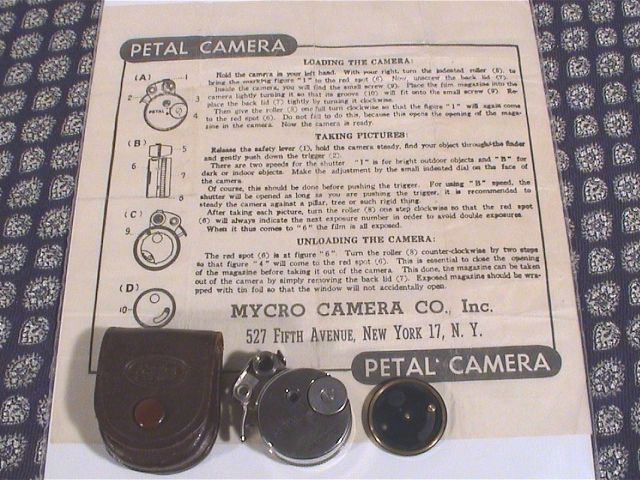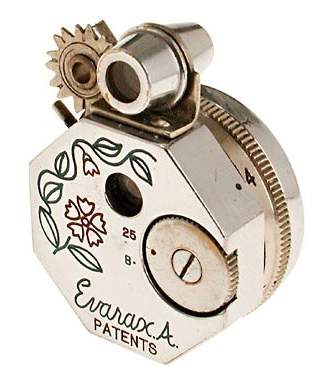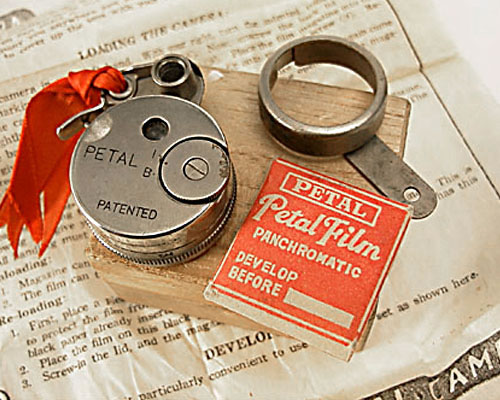

The Petal Camera is one of the more prized collectible subminiature cameras. The first model, the round version, is not particularly rare but it still commands a fairly high price on the collector's market. The octagon-shaped Petal is definitely less common and more expensive. And the most rare version of all, the Everax, is the most expensive of all. Collectors will pay extra for the small red tag of fabric often found tied to the viewfinder window and even more for the standard wooden box which houses the camera. All versions are great fun because the camera itself is amusing and its manufacturer provided all sorts of accessory equipment to facilitate their use. Taking pictures with any of them is another matter altogether and is best left to truly enthusiastic collectors or those with simply too much time on their hands.


The original round Petal camera was first manufactured by the St. Peter Optical Company of Japan in 1948. At an inch and a quarter round, it was the smallest production camera to that time. It had a simple fixed focus 12mm f/5.6 lens with a simple B and I shutter. A round film disk was fitted into the back of the camera. Like the Photoret, the Stirns Vest Camera and other round cameras which used a single sheet of round film, the Petal moved the film into position behind the lens by rotating the rear half of the camera. In the case of the Petal, rotating the back moved the 25mm disk of film so that individual 6mm images could be made.
An octagon shaped Petal appeared later in that same year or the following year. This camera was manufactured by the Sakura Seiki Company and was identical to the first Petal other than in shape. Despite the difference in appearance, camera backs of the two Petal cameras are interchangeable. No one has offered an explanation for why the second version was octagon shaped but it is definitely more attractive. This version is more expensive and makes an even more prized collectible.
The Everax A, essentially the octagonal body of the second Petal with the addition of lovely flower engraving on the front panel, was the third version of this camera. The Everax was also manufactured by the Petal Optical Company in 1948 or 1949. It had a 13mm f/6.3 lens and simple B and I shutter. Everax camera backs are interchangeable with those of the first two Petal models.
Despite cosmetic differences, all Petal versions work the same way. The little glass window is the lens, the shutter is set with the large front surface wheel and the top side trigger snaps the picture. Ideally, the camera should be purchased in its complete form which included a small red fabric tag attached to the viewfinder and a wooden box. Most often the camera is found without these accoutrements.
Several obstacles must be overcome should the spirit move someone to actually take pictures with the Petal camera. The first problem is finding film to fit into the camera back. Because the film holder must use a perfectly round 25mm disk, it hard to improvise by using a pair of scissors to cut out a film round. Fortunately, the manufacturer produced a large stamp or film punch which actually works very well, especially in full daylight. Unhappily, it must be loaded and used in total darkness and therefore requires a little practice.

The stamp operates much as you might imagine. You place a piece of film in the slot and stamp on the top. You then have a round piece of film of the proper dimensions. You must then load this disk into the round camera back cartridge before turning the lights on. In 1948, it is likely the camera manufacturer believed it best to use orthochromatic film since it can be handled safely under a red light. Cutting panchromatic film is more difficult because it must be done in total darkness. Loading the film involves simply fitting the film disk into the thin cassette in the camera back. After you have loaded the back, put it on the camera, and screw the camera back to the front of the camera and make sure that the number one is the first number next to the film counter mark. You are now ready to take pictures.
If you have never held a Petal, you are in for a shock. To put it in simple terms, the Petal is not exactly ergonomic. In other words, it is really hell holding the camera to take pictures. But, assuming you are patient [as you must have been to cut the film and then load it] taking pictures is surely no more difficult. Look through the viewfinder window and press the small lever carefully so that you do not shake the camera. Easier said than done. After snapping the picture, rotate the back to the next number.
Processing Petal film is more difficult than you might think because it is difficult to keep the film from laying on the bottom of your tank. Potential Petal users will be happy to learn that the manufacturer made special film holders to hold the film during processing. You simply push the film disk into place in the dark, dunk it into the developer and wait. It will help if you tie a string to the end of the film holder before closing the tank so that you can then turn lights on until developing time is over. Everything else is like working with regular film. Of course, one should not remove the film from the holder until it is totally dry because, if you remove the small film round, it will be difficult to find a place for a clothes pin.
Enlarging is simple. Let me put it this way; if you have ever enlarged any small negative, you will have no trouble with the Petal negative. Any Minox enlarger will do a splendid job because the film round can be easily manoeuvred into place. Other enlargers will require carefully placing the film round into the holder without scratching.
If you really wish to take pictures with your Petal camera, I would offer the following advice. First, learn to operate the shutter without shaking the camera. Second, use orthochromatic film rather than panchromatic film because the former can be handled under a red safe light. Most available orthochromatic emulsions are very slow because they are made for microfilm reproduction. But Agfa makes a slow 25 ISO film in 35mm size and after cutting it into a rough square, it can be moulded with a small scissor to fit the film back in the dim light. Your images may be missing a small piece from the scissor tailoring, but it will be amazing if you can get anything on film anyway. Even a good negative will produce only a vaguely acceptable 4x6 inch picture and a 2x3 inch picture more happily.
Given the high cost of the camera itself, the difficulties in making usable film for its use, the difficulty of taking a picture without camera shake and the problems involved with processing and enlarging the negative, you wonder why anyone would bother. But even if you have never tried taking pictures with a Petal, you can now understand why the very inexpensive Minolta 16 is so popular among subminiature users but why the Petal remains a lovely collectible.
©1997 Jerry Friedman
Jerry Friedman teaches European history at Kent State University, Kent, Ohio, 44242, and can be contacted at that address or online at jseala@bgnet.bgsu.edu
Note- Images of round Petal, octagonal Petal, Everax and film punch which appear in printed article, not available at this time.
introduction | the petal | Guinness World Record
Last Updated on 22nd October 2003